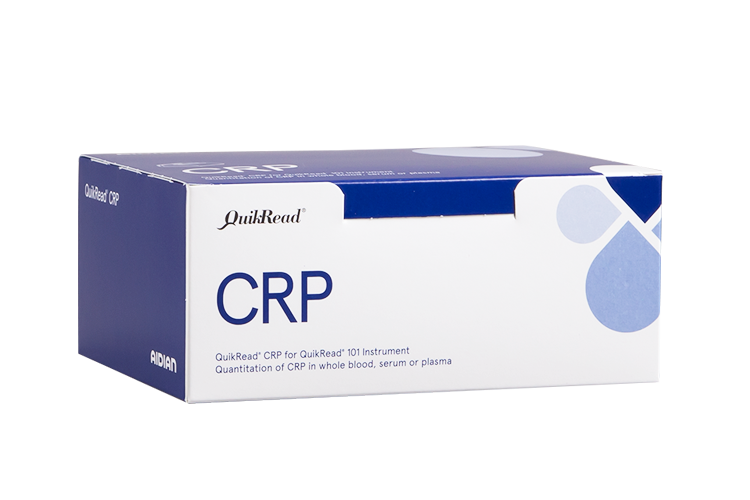QuikRead CRP
QuikRead CRP test is intended for quantitative measurement of C-reactive protein (CRP) in whole blood, plasma and serum samples with the QuikRead 101 instrument. This simple and robust system gives reproducible results in just a few minutes.

Generally
Measurement of CRP can be helpful in the clinical management of a patient with infection symptoms. CRP is normally present in low concentrations in the blood of healthy people. CRP concentrations are markedly increased in the event of bacterial infection, whereas viral infections normally induce only a modest elevation or no elevation at all.
QuikRead CRP is a simple test for quantitative measurement of CRP. The system - consisting of a small instrument and a ready-to-use kit - is designed for use in primary healthcare settings. When the test is performed near the patient, the result is available during patient consultation and can, therefore, guide antibiotic use.
QuikRead CRP provides you with
Reliability
- As accurate as a laboratory test
- Reproducible CRP result within 8 - 160 mg/l range
Speed
- Result available when needed - in less than 3 minutes
Ease of use
- The system is easy to operate, even by non-laboratory personnel
- Performed on a finger prick blood sample (alternatively serum or plasma sample)
- Built-in calibration
Test results should never be used alone, without a complete clinical evaluation.
QuikRead CRP is not registered in the USA.
Technical data
| Products available |
|
| Use | For in vitro diagnostic use, IVD CE |
| Method | Immunoturbidimetric |
| Sample type | Whole blood, serum, plasma |
| Instrument information | QuikRead 101 Instrument |
| Measurement time | Less than 3 minutes |
| Reading of the result | Instrument read |
| Storage | 2 - 8 °C |
| Shelf life | 15 months (theoretical) |
| Transportation | 2 - 8 °C |
| Size and weight | 190 x 140 x 80 mm |
| Additionally needed |
|
| Full export carton of kits | 576/672 |
| Country of origin | Finland |
| Registration | Not registered in the USA |
| Registered trademark | QuikRead® is a registered trademark of Aidian Oy |
About C-reactive protein (CRP)
CRP aids clinical management of patients with infections or inflammatory conditions.
Learn more: About C-reactive protein
Antimicrobial resistance and CRP
Antimicrobial resistance is a global health threat. CRP point of care testing aids management of respiratory infections and fighting against antimicrobial resistance.
Learn more: Antimicrobial resistance and CRP
Documents and materials
Marketing and sales materials
QuikRead go Control Information (EN)
Instructions for Fingertip Blood Collection (EN)
Instructions for use
(For informative use only. Kindly always refer to the latest package insert in the kit.)
QuikRead CRP Prefilled Cuvettes IFU (GB, DE, FR, IT), 134191
QuikRead CRP Prefilled Cuvettes IFU (CZ, SK, HU, PL), 134191
QuikRead CRP Prefilled Cuvettes IFU (SI, RS, HR, GR), 134191
QuikRead CRP Prefilled Cuvettes IFU (TR, PT, FI, SE), 134191
QuikRead CRP Control IFU (GB, DE, FR, ES, IT, CZ, SK, SI, SR, EE, SE, NO, DK, FI), 154812
154983 IFU QR CRP Control Revision History 154812
Safety Data Sheet
If you wish to receive a Safety data sheet, please contact: product.support@aidian.eu
Frequently asked questions
The QuikRead instrument gives me a result of > 160 mg/l, but I would like to get an exact CRP result. Is it possible?
When using plasma/serum samples you can dilute the sample with 0.9% NaCl before adding it to the cuvette. The recommended dilution is 1+1. Remember to multiply the result by 2.
I accidentally left a QuikRead CRP kit at room temperature for a weekend. Can I still use it?
Yes, you can use the kit. The kit can be stored at room temperature (18 - 25 °C) for one month. When used at room temperature during daily working hours (7.5 hours) and stored at +2 - +8 °C after finishing, the kit will remain stable for 3 months.
I have used a 20 µl sample volume for plasma patient samples. Is the result I get the final result?
No, when using a 20 µl plasma volume, the result should be multiplied by 0.6. When using a 12 µl plasma or serum volume, the result can be directly read from the screen and no additional calculations are needed.


